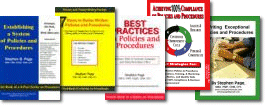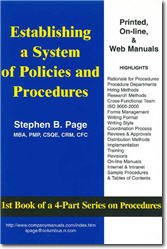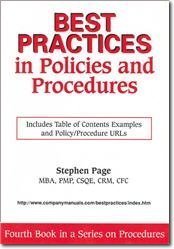Policies, Procedures, and Business Processes – Easy to Use Writing Methods – Free Template
Policies and Procedures |
||
stevebpage@gmail.com |
||
Please ask me questions anytime. |
||
5-Book Set |
Buy from Amazon.com |
|
1280+ Pages |
Special only available from AUTHOR: 5-Book PDF Set for $72.00, 55% off Retail |
|
***CLICK PRICE-LIST Page to GET this SPECIAL*** |
||
Click Book Cover |
Book Highlights, Definitions, and Book Themes |
FIRST BOOK |
Establishing a System of Policies and Procedures – Introduction and Basic Primer.
Use a proven “Writing Format Template” for policy and procedure documents (template provided FREE with every order) that will become the “focus” or “heart” of your policy and procedure program. Without a logical, consistent layout for your words and sentences, your documents may be difficult to read and apply to real-world situations by your readers, customers, and management.
Discover how the “Art of Writing Policies and Procedures” is actually a methodology in itself. The methodology encompasses instructions for: Researching, Writing, Editing, Approving, Publishing, Communicating, Training, Improving, and Revisions. Each of these phases will help you to "collect information," "write a draft," "get the draft reviewed and approved," "publish the document and communicate/train it," "make improvements," and "make subsequent reviews."
|
|
SECOND BOOK |
7 Steps to Better Written Policies and Procedures – Do’s and Don’ts of Writing Policies and Procedures. 136 pages. Follow along with a case study, scenarios, and writing exercises. The result is a well-written policy or procedure document!!!
This book contains individual chapters on each of the 8 section headings contained in the Writing Format Template. The 8 required section headings and 2 optional section headings are shown below:
Learn why the writing format is an ENABLER to help you write policies and procedures consistently, logically, and clearly every time. Easily fill in the blanks of this “provided template” using preset Microsoft styles. Add your own section headings, e.g. Inquiries or Appendices. Email me with any questions about using this template or any other concern or challenge.
|
THIRD BOOK |
Best Practices in Policies and Procedures – Best of the Best Writing Methods.
The primary subjects of this book include but are not limited to:
NOTE: The URL references in this book are likely to be out of date. Instead of trying to maintain the URLs, I ask that you please email me for added methods for searching the Internet for table of contents pages. Invaluable aid.
|
FOURTH BOOK |
Achieving 100% Compliance of Policies and Procedures – Advanced book that uses a case study and scenarios to show you how to make significant improvements to the processes contained within your existing policies or procedures and/or for making improvements to newly written policies and procedures. 380 pages.
This book focuses on using simple statistics and metrics to make continuous improvements to your policy and procedure documents. No other book takes this approach to actually show you how to improve document content.
A case study is incorporated into most chapters of this book; the case study begins by taking an “outdated” procedure from a procurement department. Then, as I address writing, reviewing, training, communicating, and improvements, in great detail (as opposed to my other books that present the basics), I will show you how to use metrics and very simple statistics to make improvements and achieve cost savings to this "outdated" procurement procedure.
In one of the last chapters of this book, you will find a new "updated" and "significantly improved" procedure that emerges as a result of the many advanced principles that you are introduced to in this book.
NOTE: Metrics and statistics have always bothered me because I was afraid of them. I have found a way to introduce metrics and statistics in this book that I hope you will find to be easy to follow. Metrics and statistics are quite useful when it becomes necessary to prove to your management the value of your documents and of your job!
|
|
Click
FIFTH BOOK |
Writing Effective and Successful Policies and Procedures – This book is your best buy as it encompasses three of my books other than Achieving 100 percent compliance of policies and procedures; this book is best used to set up a policies and procedures program from scratch. This book is just $9.99 on Kindle. You can always buy the PDF directly from me at this site for just $29.95, and I will give you permission to print it out.
I wrote this book in a writing style very different from other books. I tried to get into your mind as you read. I try to anticipate your thoughts and concerns. I know how tedious it can be to read a book on policies and procedures, so I tried to anticipate your concerns and challenges. I hope you look the way this book is written.
Be introduced to the 18 most important decisions to setting up a successful policies and procedures program. These decisions are essential to every policies and procedures writer/manager as they contain the minimum decisions required to set up a policies and procedures department/program.
A few of these important decisions include:
At the end of this book, I have included an Appendix section that contains 10 policy/procedure documents written in my provided Writing Format Template; I included these samples to give you a sense of what a “real” document might look like. These documents are shorter than normal --- I just wanted to show you the format in action. If you want a longer sample, please reach out to me.
PLEASE NOTE that the FIRST sample PROCEDURE, “Procedure on Procedures,” is a document that you can use as your own – insert your logo, change the organization name throughout, and insert the final management decisions as a result of the 18 decisions. This document is written with extensive detail.
You have my permission to publish this document as you see fit. NOTE: I do not authorize you marketing this "Procedure on Procedures" document in any way. I only give you permission to use this template within your policies and procedures program/manual within your current organization or company. |
|
|
Definitions |
Minimum definitions you need to know and understand |
Policies and Procedures |
Policies and procedures are documents used by companies and organizations to provide the authority, decisions, and actions necessary to guide a company or a single department on general or specific topics, e.g. Document titles might be: Hiring Practices or Bank Accounts or Capital Funding or Contract Administration.
Using my books, you can learn to write clear, consistent, logical, and reliable policies and procedures every time. The important goal is to be consistent from document to document, never changing format or style of writing. My methods and business processes are currently being used by companies and organizations in more than 125 countries. |
Policy |
A POLICY sets the rules, framework, and/or standards that guide or influence future decisions and overall direction. The intent of a policy within a document is to set a mandate, provide a strategic direction, or state management’s position on a situation, rule, standard, guideline, action, or behavior. |
Procedure |
A PROCEDURE documents a course of action to be accomplished in a defined order, ensuring a consistent and repetitive approach to specific actions or behaviors. Procedures identify people, places, business processes, forms, and actions necessary to carry out one or more policies and/or to support other policies and procedures. I see procedures as business processes or business activities. |
Guideline vs. Standard |
A GUIDELINE is a recommendation that should be followed versus a STANDARD that must be followed. While guidelines are never mandatory, I tend to use the word, “Guidelines” in my Policy/Procedure Titles only as a cue to the reader as what is contained within the document, e.g. if I have a title of “Recruitment,” it’s not clear what is going to follow; however, if I have a title of “Recruitment of Management Employees Guidelines,” to me it’s clear that I am going find information about how to recruit managers to work for an organization. To me, in most cases, GUIDELINES have the same meaning or use as Standards - while I may give you choices, my Guidelines are still required. However you choose to make use of these terms, "guidelines" or "standards," please stick with the words you select so that there is consistency from document to document. |





